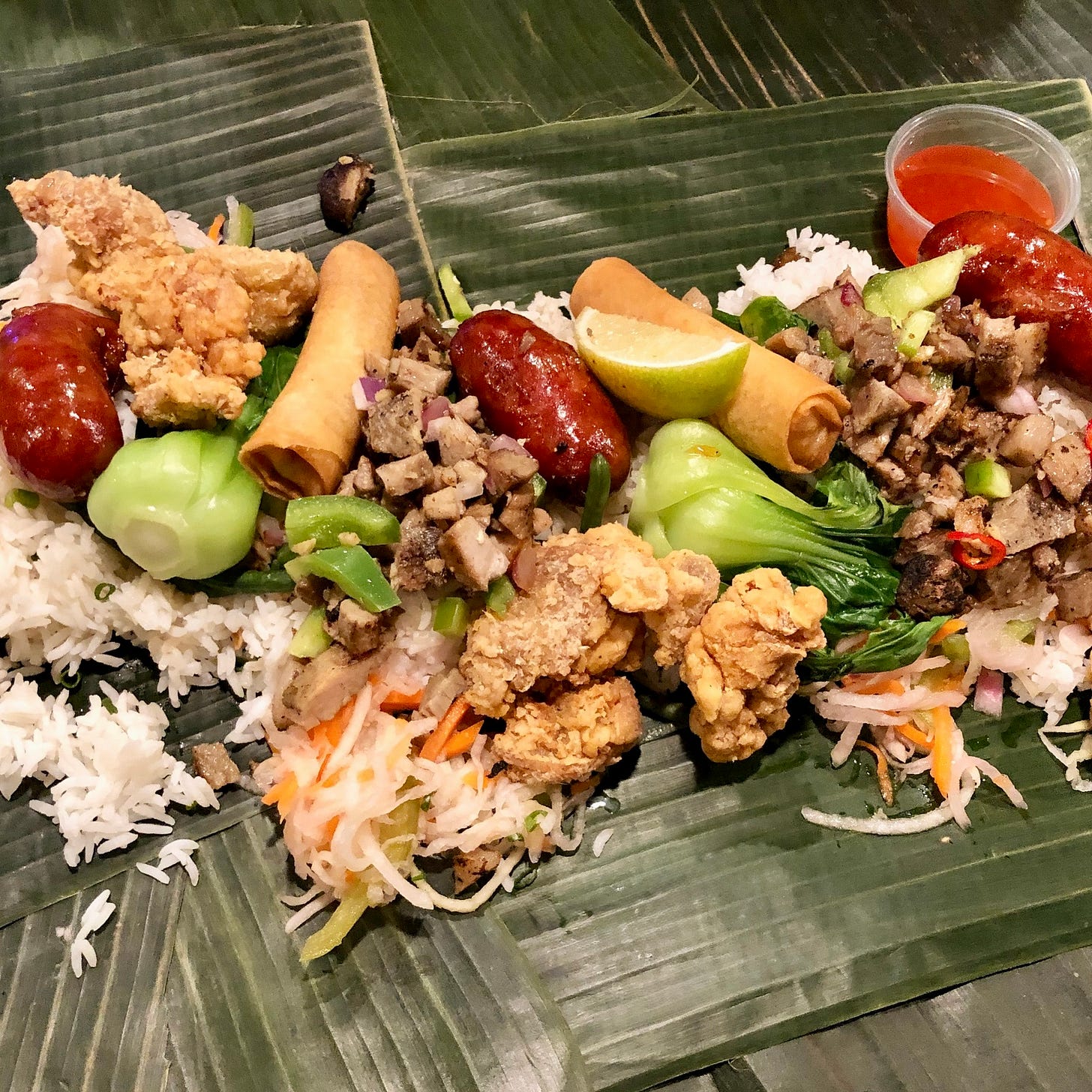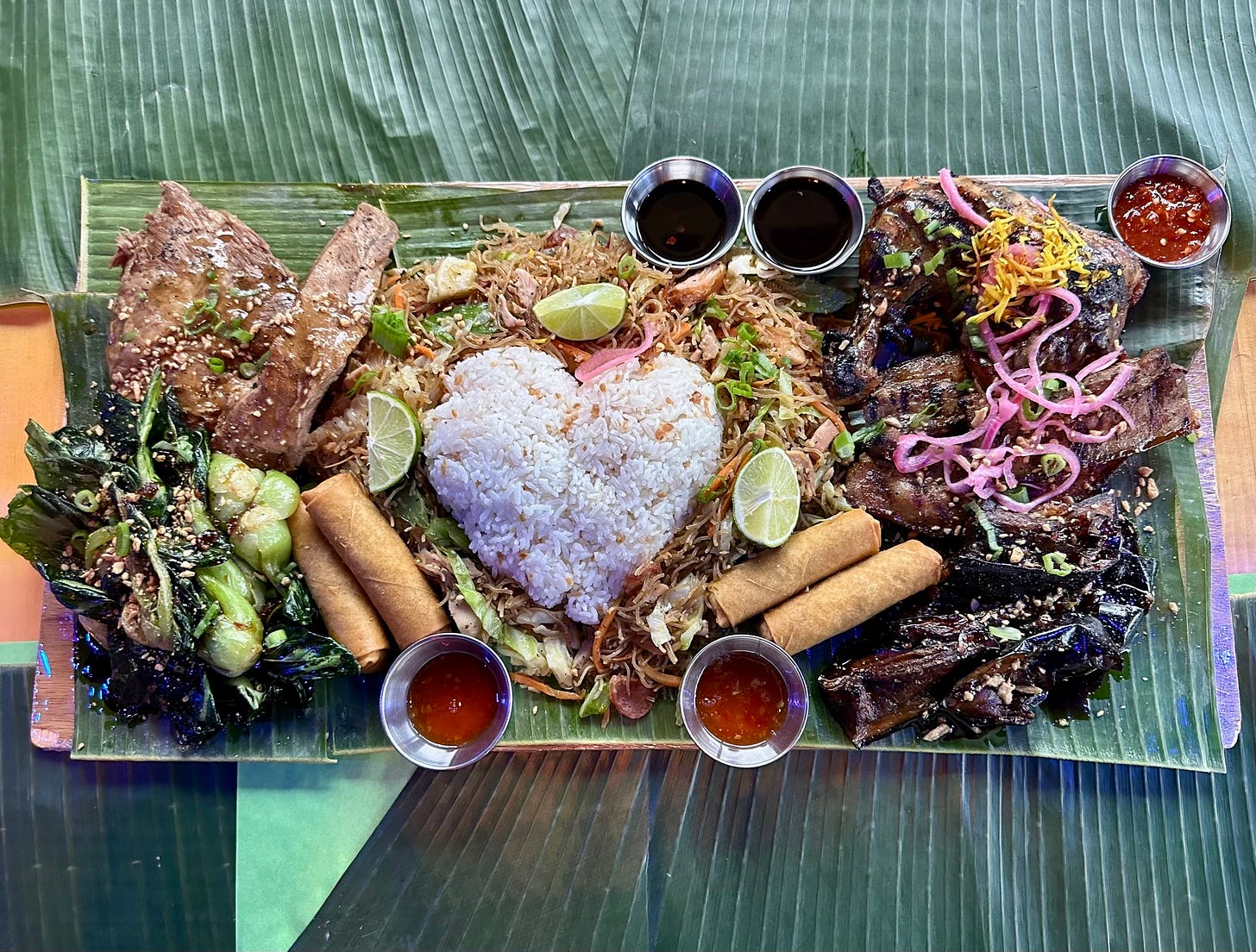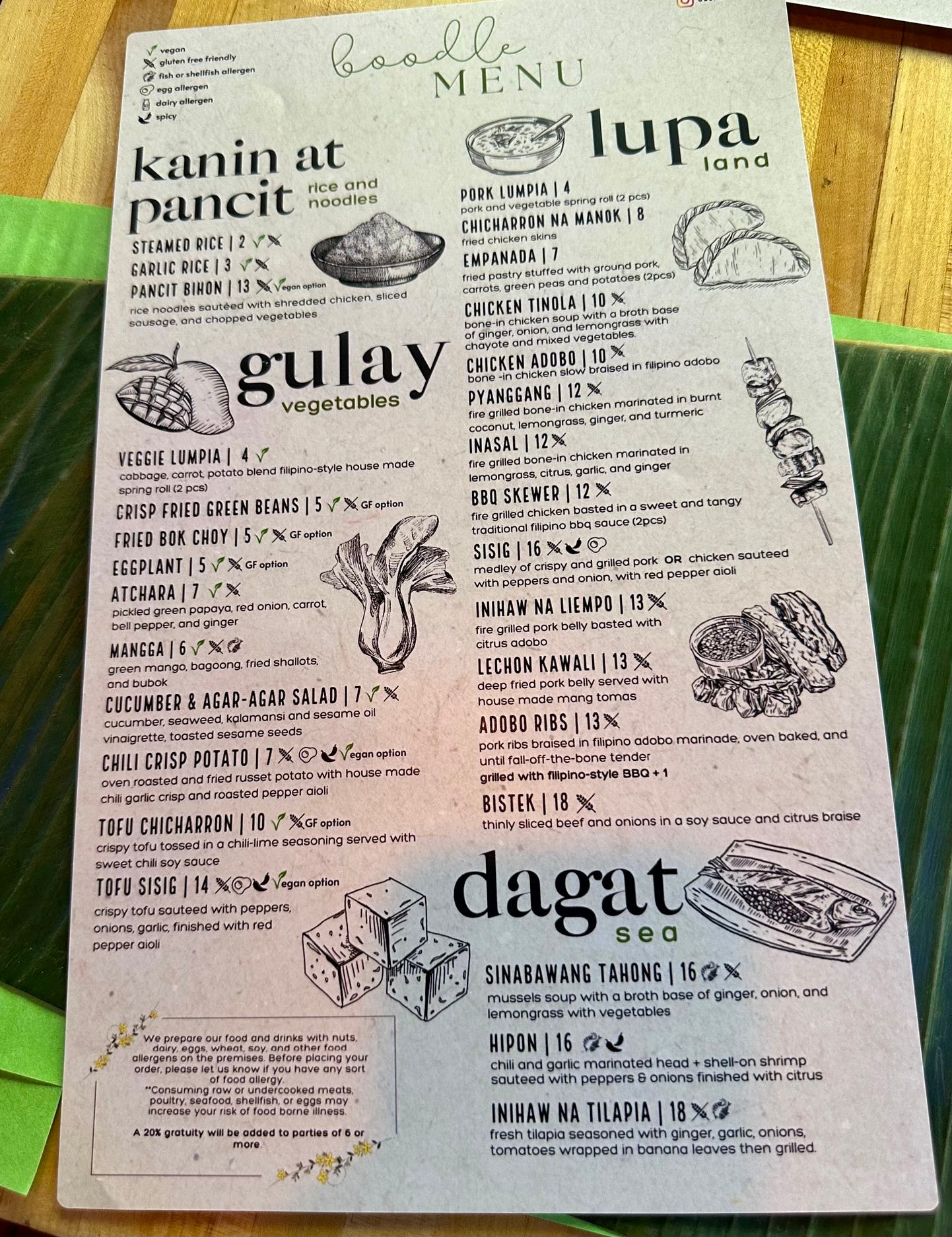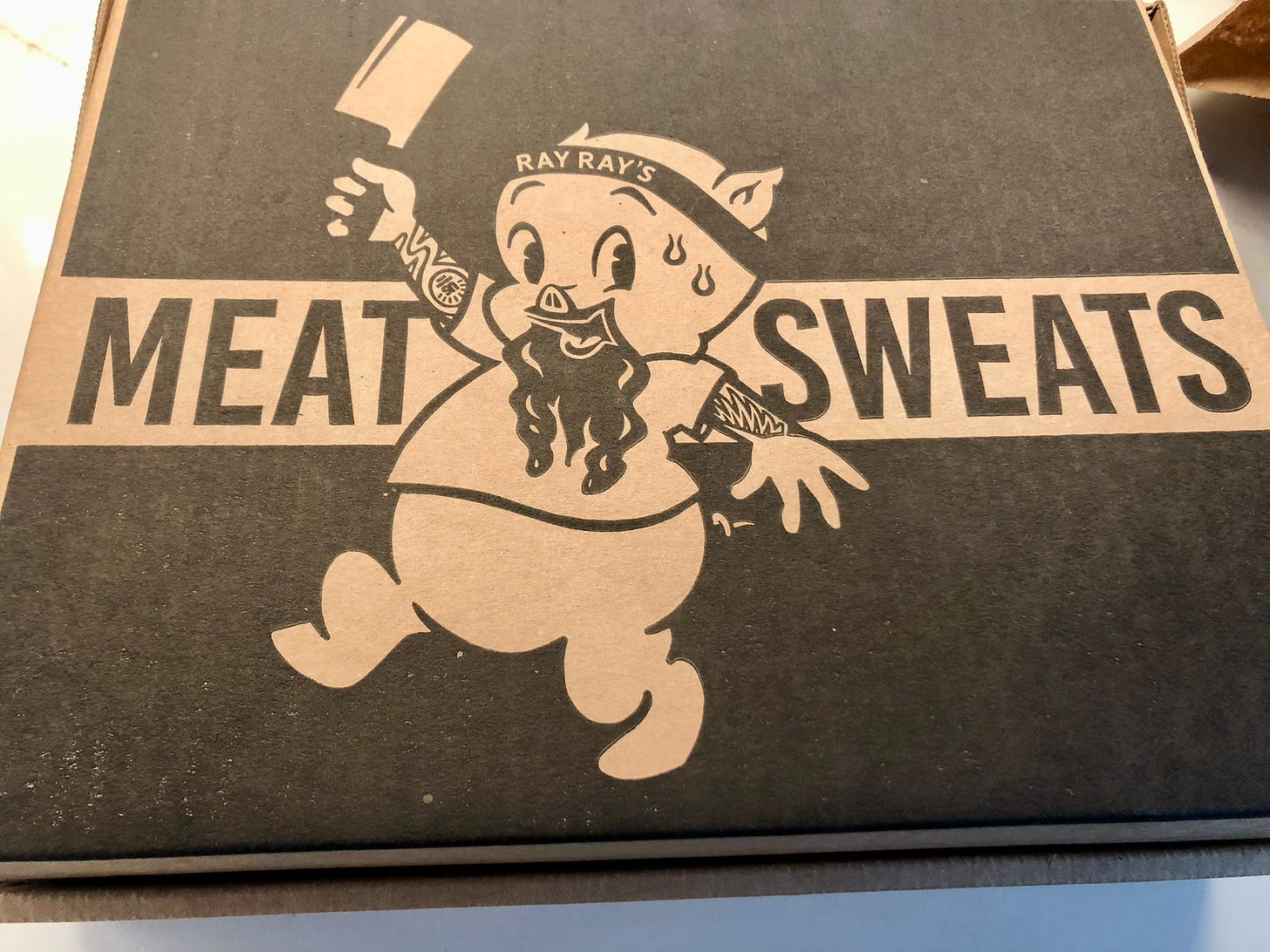There's No Fighting It: You Need to Experience Bonifacio's Boodle Night
Plus, Ray Ray’s starts a new chapter in Clintonville, and a local Jamaican eatery is expanding.
Bonifacio’s Boodle Night Remains a Must-Try, Hands-On Experience
By Bethia Woolf
Last week, I attended a Boodle Night at Bonifacio with one of our tour guides, Joe Arcilla, who is Filipino American. Unsurprisingly—given his role as a food tour guide—Joe is a foodie, a trait I’ve noticed is common among many Filipinos I’ve met. The dinner reminded me just how enjoyable a Filipino dining experience can be.
Bonifacio introduced its Boodle Night dinners in 2017 during a time when Filipino cuisine was gaining more mainstream attention—thanks, in part, to social media.
Boodle, like the more traditional kamayan feast, is a style of communal Filipino dining. (Although often used interchangeably, “boodle” and “kamayan” have different origins and nuances.) With their green banana leaf backdrops and mounds of delicious food, both meals are photogenic and perfect for Instagram. They represent much more than food-centric content, however, as these meals have become a meaningful way for Filipino Americans to connect with their heritage, express cultural pride and share traditions with others.
Kamayan comes from the Tagalog word “kamay,” meaning "hand," and refers to the traditional practice of eating with one's hands. This was the norm in the Philippines before Spanish colonization. Today, kamayan meals are typically festive and associated with communal gatherings rather than just the act of eating by hand. Bonifacio’s chef, MJ Hernandez, says he associates kamayan meals with celebration and feasting.
The term “boodle,” on the other hand, has military roots. During the U.S. colonial period, the army introduced “boodle fights” as a mess hall tradition to foster camaraderie among soldiers of various ranks and backgrounds. “Boodle” was military slang for personal items—snacks and candy included—and is believed to have come from the phrase “kit and kaboodle.” Over time, the term came to represent large, informal group meals. Hernandez notes that boodle dining conveys a sense of unity—one that’s a little chaotic and a lot of fun.
Both kamayan and boodle dinners are cultural practices that promote sharing and interaction. Dishes are served on banana leaves that double as both table covering and plate. It’s somewhat similar to Ethiopian communal dining although, unlike injera, banana leaves are not edible.
Typically, the meal begins with a base layer of rice—often sinangag, the Filipino-favorite garlic fried rice—that is laid down the center of the table. Surrounding it are a variety of ulam (main dishes), which may include Filipino staples such as lechon kawali, grilled chicken, barbecue skewers, bistek, seafood, and, of course, lumpia—it’s hard to imagine a Filipino gathering without these crispy spring rolls.

Jeepney, a Filipino restaurant in New York City that opened in 2012, is credited with pioneering the kamayan trend in the United States. Bonifacio, which opened in the summer of 2016, began offering kamayan and boodle dinners as pop-ups aimed at drawing in new customers. The events became so popular that the Grandview-area restaurant decided to host them more frequently—even offering a clever to-go version during the pandemic.
Over time, these communal meals evolved into a signature part of Bonifacio’s success. The restaurant initially focused on kamayan experiences (set dinners with specific themes and communal, meet-your-neighbor seating), but found that Boodle Nights (in which guests order what they like and sit with their own group) offered greater flexibility and were easier to replicate for regular service.
Communal dining is central to Filipino culture, and large potlucks are commonplace. Eating together reflects the values of generosity, community and a deep appreciation for food.
When I spoke with Joe and other Filipino American friends about their childhood memories, I was surprised to learn that many of them had their first kamayan experience at Bonifacio. While they fondly recalled extended family potlucks and buffet-style meals, eating from banana leaves spread across the center of the table was something new. Chef Hernandez attributes this partly to the past difficulty of sourcing banana leaves in the U.S. In contrast, Hernandez recalls growing up in Manila (where banana leaves are easily accessible) and having frequent kamayan-style meals both at restaurants and for family picnics.
Bonifacio now offers Boodle Night three times a week: Tuesdays, Thursdays and Sundays. Diners order à la carte, and dishes arrive on a banana leaf-covered board placed at the center of the table. Each person gets an individual banana leaf place setting. The menu includes options such as steamed or garlic rice, pancit noodles, a variety of vegetables, a wide selection of proteins and snacks like lumpia, chicharrón and empanadas. Our server recommended one snack, one protein, one vegetable and one rice dish per person.

While browsing the menu, Joe noted that the Philippines has over 7,000 islands so there is a lot of variation in dishes across the country and many versions of the same dish. He pointed out some of the influences on Filipino cuisine from both Chinese (lumpia, pancit) and Spanish (adobo, empanadas) cuisines. He also highlighted the pyanggang chicken—a regional specialty from the southern Philippine island of Mindanao, where Bonifacio’s owner, Krizzia Yanga, has family roots. With its proximity to Malaysia and Indonesia, Mindanao’s cuisine has a distinct flavor profile. The pyanggang chicken is marinated in burnt coconut, lemongrass, ginger and turmeric, resulting in a beautifully caramelized, smoky flavor that I highly recommend.
We also tried the inihaw na liempo, a grilled pork belly dish basted with citrus adobo. We selected it over the more traditional lechon kawali, which is deep-fried pork belly, though both are excellent choices for pork lovers. The adobo ribs, another server suggestion, were tender and satisfying. Unfortunately, the kitchen had run out of atchara (pickled green papaya) and mangga (green mango with shrimp paste), but the bok choy and eggplant dishes were delicious. And, of course, we had lumpia.

The food arrives on its communal board, and then it’s time to dig in. Joe demonstrated the traditional technique of forming a small mound of rice and meat with the fingers, then using the thumb to push the food neatly into the mouth. The goal is to use fingers, not the whole hand. Some of the dishes like lumpia, barbecue skewers, lechon kawali and bistek are easier to eat with your hands than others.
Tips for Boodle Night at Bonifacio:
Make a reservation well in advance. Boodle Nights fill up fast.
You can enjoy Boodle Night with any size party, but it's great with a group because you get to try more dishes.
The last Tuesday of the month is karaoke night at Bonifacio, so expect a lively, festive atmosphere. Karaoke is a very popular Pinoy pastime.
Wash your hands before eating. Wet naps are provided afterward.
Expect to get a little messy, especially if you’re new to eating rice with your hands. Gloves and utensils are available if needed. Take photos before you start eating!
Save room for dessert. Bonifacio offers excellent sweets, including halo-halo, turon and leche flan. I, unfortunately, ran out of room.
Find It:
1577 King Ave., Fifth by Northwest
614-914-8115
Notes
Around the Columbus Food & Drink Scene
Mi Yaad, the Jamaican food vendor inside Saraga on Hamilton Road, is adding a new restaurant at 6475 Tussing Road in Reynoldsburg. According to an announcement on Instagram, the Mi Yaad expansion means new menu items, dine-in and drive-thru service. Mi Yaad specializes in traditional Jamaican dishes such as jerk chicken, curry goat, escovitch fish, oxtail and more.
The Ray Ray’s Hog Pit truck is no longer parked outside Ace of Cups, but Ray Ray’s new Clintonville storefront is now open at 4214 N. High St. The new location is open for dining inside and out from 11 a.m. to 9 p.m. Tuesday through Sunday.
In case you missed it, Columbus is poised to add yet another house of steak. Losanti, an upscale steakhouse based in Cincinnati, will soon be taking over the 6,000-square-foot space at 440 W. Broad St. in Franklinton, which formerly housed Taft’s Brewpourium.
Tickets are now on sale for the grand opening weekend of DoG Distilling Co., a new distillery in Delaware County. Grand opening festivities will take place June 13-15 at 3773 E. Powell Road, where visitors can check out the distillery’s Still House Bar. DoG currently has two bottled offerings, a 4-year straight bourbon whiskey and 3-year rye whiskey.






